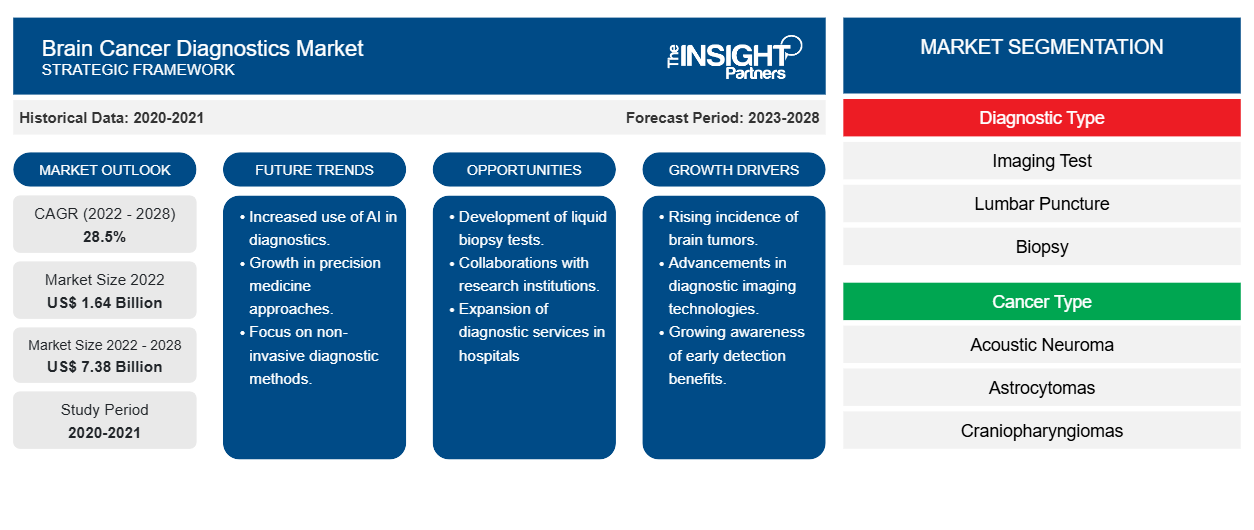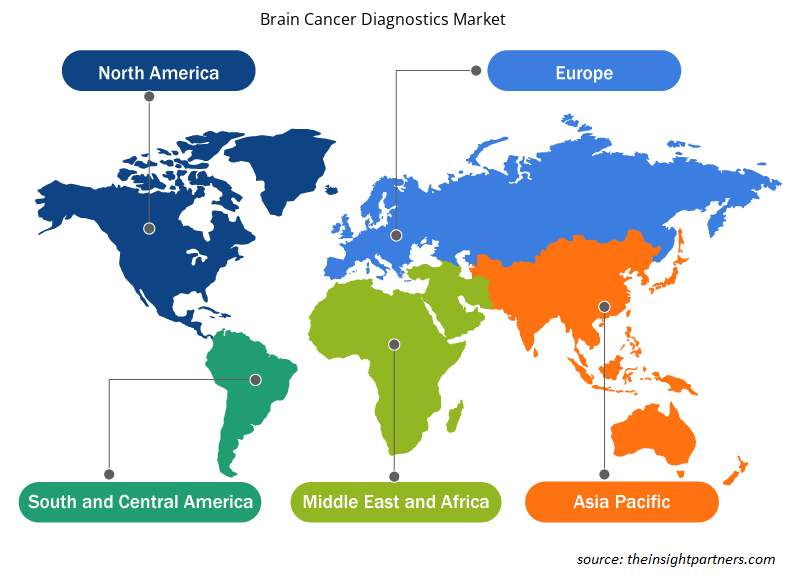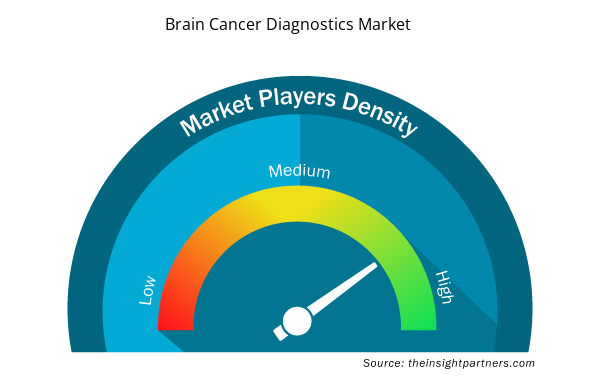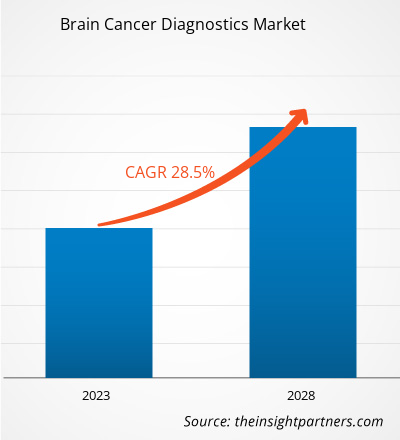The brain cancer diagnostics market is projected to reach US$ 7,378.57 Million by 2028 from US$ 1,639.10 Million in 2022; it is estimated to grow at a CAGR of 28.5% from 2022 to 2028.
Brain cancers are caused due to extracellular growth of the cells in the brain that causes tumors. The tumor includes primary brain tumors and secondary brain tumors. Primary brain tumors are formed in the brain and do not spread to other body parts, whereas secondary tumors, also known as metastases, are those cancers that began in another part of the body. Brain tumors are categorized into 40 major types that are further classified into two major groups, including benign, i.e., slow-growing and have less possibility to spread, and malignant, i.e., cancerous, and more likely to spread.
The brain cancer diagnostics market is segmented into diagnostic type, cancer type, end user, tumor size, and geography. The market , by geography, is broadly segmented into North America, Europe, Asia Pacific, the Middle East & Africa, and South and Central America. The report offers in-depth insights into the market, emphasizing parameters such as market trends, technological advancements, and market dynamics, along with an analysis of the competitive landscape of leading market players.
Customize This Report To Suit Your Requirement
You will get customization on any report - free of charge - including parts of this report, or country-level analysis, Excel Data pack, as well as avail great offers and discounts for start-ups & universities
Brain Cancer Diagnostics Market: Strategic Insights

- Get Top Key Market Trends of this report.This FREE sample will include data analysis, ranging from market trends to estimates and forecasts.
You will get customization on any report - free of charge - including parts of this report, or country-level analysis, Excel Data pack, as well as avail great offers and discounts for start-ups & universities
Brain Cancer Diagnostics Market: Strategic Insights

- Get Top Key Market Trends of this report.This FREE sample will include data analysis, ranging from market trends to estimates and forecasts.
Market Insights
Rising Incidences of Brain Tumors Contributes Significantly to Market Growth
According to the American Society of Clinical Oncology (ASCO), in 2021, around 24,530 adults (13,840 men and 10,690 women) were diagnosed with primary cancerous tumors of the brain and spinal cord in the US. In a person's lifetime, the chances of having this form of tumor are fewer than 1%. Most primary central nervous system (CNS) malignancies are brain tumors, which account for 85% to 90% of all cases. Brain tumors can be fatal, severely impact the quality of life, and ultimately transform a patient's and their family's lives.
Similarly, Cancer Research UK estimated that around 12,288 new cases of brain, other CNS, and intracranial tumors are diagnosed in the UK each year, which makes it around 34 cases per day (2016–2018). Brain tumors, other central nervous systems, and intracranial tumors are the ninth most common malignancies in the UK, accounting for 3% of all new cancer cases (2016–2018). Also, it is the 7th most common cancer in females in the UK, with around 6,400 new cases during 2016–2018. Similarly, in males, brain, other CNS, and intracranial tumors are the 11th most common cancer, with about 5,800 new cases in the UK during 2016–2018. Incidence rates for brain tumors are highest in people aged 85 to 89 (2016-2018) in the UK.
According to the American Association of Neurological Surgeons, glioblastoma is the most common malignant brain and other CNS tumor, accounting for 47.7% of all cases; the incidence of glioblastoma is 3.21 per 100,000 people. According to Cancer Australia, around 1,879 new cases of brain cancer were diagnosed in Australia in 2020.
Early detection of tumors often provides more treatment options. Advanced imaging technology can pinpoint the location of brain tumors. Intraoperative MRI can also guide tissue biopsy and tumor resection during surgery. Magnetic resonance spectroscopy (MRS) is used to examine the chemical characteristics of tumors. Thus, the increase in the prevalence of brain cancer worldwide highly demands brain cancer diagnostic tools.
Diagnostic Type-Based Insights
Based on diagnostic type, the brain cancer diagnostics market is segmented into imaging test, lumbar puncture, biopsy, molecular testing, platform and services, cerebral arteriogram, neurological and hearing tests/neurocognitive assessments, electroencephalography (EEG), and others. Furthermore, the imaging test segment is sub-segmented into MRI, CT Scan, PET, and others. Similarly, the platform and services segment is sub-segmented into sample slide, autosampler unit, solutions and platform, and services. In 2022, the imaging test segment is likely to account for the largest share of the market. However, the platform and services segment is anticipated to register the highest CAGR in the brain cancer diagnostics market during the forecast period of 2022 to 2028.
Cancer Type-Based Insights
The global brain cancer diagnostics market , based on cancer type, is segmented into acoustic neuroma, astrocytomas, craniopharyngiomas, ganglioneuromas, glioblastoma multiforme, meningiomas, ependymomas, oligodendroglioma, low-grade tumors, and other brain cancer types. In 2022, the glioblastoma multiforme segment is likely to hold the largest share of the market. Moreover, the same segment is expected to witness growth in its demand at the fastest CAGR from 2022 to 2028, owing to the rise in the incidence of glioblastoma multiforme globally.
Tumor Size-Based Insights
The global brain cancer diagnostics market , based on tumor size, is segmented into 0.2 cm3 to 100 cm3, 101 cm3 to 200 cm3, and above 200 cm3. In 2022, the 0.2 cm3 to 100 cm3 segment is likely to hold the largest share of the market. Moreover, the 0.2 cm3 to 100 cm3 segment is expected to witness growth in its demand at the fastest CAGR from 2022 to 2028, owing to the rise in the detection and diagnosis of various medical conditions globally.
End User-Based Insights
Based on end user, the brain cancer diagnostics market is segmented into hospitals, specialty clinics, ambulatory surgical centers, diagnostic centers & research institutes, and others. In 2022, the hospitals segment is likely to hold the largest share of the market. Moreover, the specialty clinics segment is expected to witness growth in its demand at the fastest CAGR of 29.4% from 2022 to 2028, owing to the adoption of advanced technologies for brain cancer diagnosis by hospitals globally.
Product launches, mergers and acquisitions are highly adopted strategies by the global brain cancer diagnostics market players. A few of the recent key market developments are listed below:
In September 2021, BioReference Laboratories, Inc., an OPKO Health company, along with its specialty oncology division, GenPath, announced the launch of OnkoSight AdvancedTM, a next-generation sequencing (NGS) assay that enables revolutionary deoxyribonucleic acid (DNA) mutational profiling of tumor samples.
Geography-Based Insights
The global brain cancer diagnostics market , by geography, is broadly segmented into North America (the US, Canada, and Mexico), Europe (France, Germany, the UK, Spain, Italy, and the Rest of Europe), Asia Pacific (China, India, Japan, Australia, South Korea, and the Rest of APAC), the Middle East & Africa (Saudi Arabia, the UAE, South Africa, and the Rest of MEA), and South & Central America (Brazil, Argentina, and the Rest of South & Central America).
Brain Cancer Diagnostics Market Regional Insights
The regional trends and factors influencing the Brain Cancer Diagnostics Market throughout the forecast period have been thoroughly explained by the analysts at Insight Partners. This section also discusses Brain Cancer Diagnostics Market segments and geography across North America, Europe, Asia Pacific, Middle East and Africa, and South and Central America.

- Get the Regional Specific Data for Brain Cancer Diagnostics Market
Brain Cancer Diagnostics Market Report Scope
| Report Attribute | Details |
|---|---|
| Market size in 2022 | US$ 1.64 Billion |
| Market Size by 2028 | US$ 7.38 Billion |
| Global CAGR (2022 - 2028) | 28.5% |
| Historical Data | 2020-2021 |
| Forecast period | 2023-2028 |
| Segments Covered |
By Diagnostic Type
|
| Regions and Countries Covered | North America
|
| Market leaders and key company profiles |
Brain Cancer Diagnostics Market Players Density: Understanding Its Impact on Business Dynamics
The Brain Cancer Diagnostics Market is growing rapidly, driven by increasing end-user demand due to factors such as evolving consumer preferences, technological advancements, and greater awareness of the product's benefits. As demand rises, businesses are expanding their offerings, innovating to meet consumer needs, and capitalizing on emerging trends, which further fuels market growth.
Market players density refers to the distribution of firms or companies operating within a particular market or industry. It indicates how many competitors (market players) are present in a given market space relative to its size or total market value.
Major Companies operating in the Brain Cancer Diagnostics Market are:
- THERMO FISHER SCIENTIFIC INC
- Siemens Healthineers AG
- GE Healthcare
- MDxHealth
- NantOmics
Disclaimer: The companies listed above are not ranked in any particular order.

- Get the Brain Cancer Diagnostics Market top key players overview
Company -Based Insights
THERMO FISHER SCIENTIFIC INC; Siemens Healthineers AG; GE Healthcare; MDxHealth; NantOmics; Biocept, Inc.; Koninklijke Philips N.V.; Canon Medical Systems; Hitachi, Ltd.; Neusoft Medical Systems; KITZ HEIDELBERG; GENPATH; NVIDIA CORPORATION; ONCORA MEDICAL; BIOMIND; SOPHIA AND ONCODNA; Clinspec Diagnostics; Raindance Technologies, Inc; ROCHE DIAGNOSTICS; and Illumina, Inc are among the leading companies operating in the brain cancer diagnostics market
- Historical Analysis (2 Years), Base Year, Forecast (7 Years) with CAGR
- PEST and SWOT Analysis
- Market Size Value / Volume - Global, Regional, Country
- Industry and Competitive Landscape
- Excel Dataset


- Industrial Inkjet Printers Market
- Helicopters Market
- Pharmacovigilance and Drug Safety Software Market
- Hummus Market
- Sweet Potato Market
- Public Key Infrastructure Market
- Europe Surety Market
- Visualization and 3D Rendering Software Market
- Medical Enzyme Technology Market
- Arterial Blood Gas Kits Market

Report Coverage
Revenue forecast, Company Analysis, Industry landscape, Growth factors, and Trends

Segment Covered
Diagnostic Type; Cancer Typ; End User ; and Tumor Size

Regional Scope
North America, Europe, Asia Pacific, Middle East & Africa, South & Central America

Country Scope
Argentina, Australia, Brazil, Canada, China, France, Germany, India, Italy, Japan, Mexico, Saudi Arabia, South Africa, South Korea, Spain, United Arab Emirates, United Kingdom, United States
Frequently Asked Questions
Which are the top companies that hold the market share in the brain cancer diagnostics market?
Koninklijke Philips N.V. and GE Healthcare are the top two companies that hold huge market shares in the brain cancer diagnostics market.
What are brain cancer diagnostics?
Brain cancers are caused due to extracellular growth of the cells in the brain that causes tumors. The tumor includes primary brain tumors and secondary brain tumors. Primary brain tumors are formed in the brain and do not spread to other body parts, whereas secondary tumors, also known as metastases, are those cancers that began in another part of the body. Brain tumors are categorized into 40 major types that are further classified into two major groups, including benign, i.e., slow-growing and have less possibility to spread, and malignant, i.e., cancerous, and more likely to spread.
What are the driving factors for the brain cancer diagnostics market across the globe?
Key factors driving the growth of this market are the increase in brain cancer worldwide and the rise in cigarette smokers expected to drive the market during the forecast period.
Which cancer type led the brain cancer diagnostics market?
In 2021, the glioblastoma multiforme segment accounted for the largest share of the market; it is further expected to continue its dominance over the forecast period. The major driving factor for the growth of the glioblastoma multiforme segment is the growing incidence of glioblastoma multiforme. Moreover, the increasing awareness about brain cancer diagnostics among the population is one of the significant factors in the growth of the glioblastoma multiforme segment.
Which diagnostics type held the largest share in the brain cancer diagnostics market?
In 2021, the imaging test held the largest share of the market by drug development type. It is expected to report a higher CAGR of 29.5% during 2021–2028.
What is the market CAGR value of the brain cancer diagnostics market during the forecast period?
The CAGR value of the brain cancer diagnostics market during the forecasted period of 2021–2028 is 28.5%.
Who are the key players in the brain cancer diagnostics market?
The brain cancer diagnostics market majorly consists of players such as THERMO FISHER SCIENTIFIC INC, Siemens Healthineers AG, GE Healthcare, MDxHealth, NantOmics, Biocept, Inc., Koninklijke Philips N.V., Canon Medical Systems, Hitachi, Ltd., Neusoft Medical Systems, KITZ HEIDELBERG, GENPATH, NVIDIA CORPORATION, ONCORA MEDICAL, BIOMIND, SOPHIA AND ONCODNA, Clinspec Diagnostics, Raindance Technologies, Inc, ROCHE DIAGNOSTICS, Illumina, Inc.
Trends and growth analysis reports related to Life Sciences : READ MORE..
The List of Companies - Brain Cancer Diagnostics Market
- THERMO FISHER SCIENTIFIC INC
- Siemens Healthineers AG
- GE Healthcare
- MDxHealth
- NantOmics
- Biocept, Inc.
- Koninklijke Philips N.V.
- Canon Medical Systems
- Hitachi, Ltd
- Neusoft Medical Systems
- KITZ HEIDELBERG
- GENPATH
- NVIDIA CORPORATION
- ONCORA MEDICAL
- BIOMIND
- SOPHIA AND ONCODNA
- Clinspec Diagnostics
- Raindance Technologies, Inc
- ROCHE DIAGNOSTICS
- Illumina, Inc.

 Get Free Sample For
Get Free Sample For